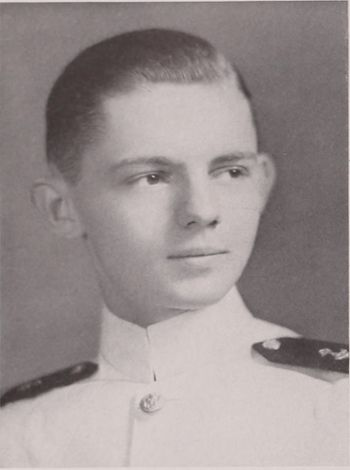ROBERT G. BRADLEY, LT, USN
Robert Bradley '43
Lucky Bag
From the 1943 Lucky Bag:
ROBERT GRAHAM BRADLEY
Washington, D.C.
There was never a dull moment around Bob. One of our Class's best exponents on swing, he was evidence that academy life could be made enjoyable. Even a military prep school background couldn't stiffen him out, and without a great concern for the threats of the Academic department, he spent most of his time playing the latest by Benny Goodman. "R.G." was stung during 2/c leave and got a greater thrill when she telephoned him, than he did in winning a place on the battalion wrestling team. His genial nature and ever-ready comradeship combined with a love of the sea make it a unanimous "shipmate" from all hands.
The Class of 1943 was graduated in June 1942 due to World War II. The entirety of 2nd class (junior) year was removed from the curriculum.

ROBERT GRAHAM BRADLEY
Washington, D.C.
There was never a dull moment around Bob. One of our Class's best exponents on swing, he was evidence that academy life could be made enjoyable. Even a military prep school background couldn't stiffen him out, and without a great concern for the threats of the Academic department, he spent most of his time playing the latest by Benny Goodman. "R.G." was stung during 2/c leave and got a greater thrill when she telephoned him, than he did in winning a place on the battalion wrestling team. His genial nature and ever-ready comradeship combined with a love of the sea make it a unanimous "shipmate" from all hands.
The Class of 1943 was graduated in June 1942 due to World War II. The entirety of 2nd class (junior) year was removed from the curriculum.
Obituary
From Wikipedia:
Robert Graham Bradley was born in Washington, D.C., on 26 September 1921. He was appointed to the United States Naval Academy on 9 June 1939, and graduated on 19 June 1942. He completed instruction at the Atlantic Subordinate Command, Service Force, Norfolk, Va. (3 July – 27 October 1942), and on 29 October reported to New York Shipbuilding Corporation, Camden, New Jersey, for the fitting out of small aircraft carrier USS Princeton (CVL-23). He served as a member of the ship’s company when Princeton was commissioned on 25 February 1943, and while on board received promotions to lieutenant, junior grade and lieutenant (1 May 1943 and 1 July 1944, respectively), as she took part in operations ranging from the occupation of Baker Island (September 1943) to the Battle of Leyte Gulf (October 1944).
While Princeton steamed with Task Group 38.3 (part of Task Force 38) in Leyte Gulf off the east coast of Luzon, Philippines (24 October 1944), a Japanese plane, tentatively identified as a Yokosuka D4Y1 Type 2 [Judy], attacked the ship. Its bomb penetrated the flight, hangar, and main decks and exploded, igniting an inferno that swept across the hangar deck. Explosions rocked the carrier, but Bradley, the ship’s assistant first lieutenant, led a repair party and battled the blaze on the second and third decks. Light cruisers USS Birmingham (CL-62) and USS Reno (CL-96), and destroyers USS Gatling (DD-671), USS Irwin (DD-794), and USS Morrison (DD-560), also fought the fire.
The intense heat compelled Bradley and his men to abandon their efforts, and after verifying that no wounded men remained behind, he entered the water at 1005, rescued soon thereafter by Morrison. Their success in fighting the fire led many of the men to believe that if they could clear the smoke from Princeton’s largely undamaged machinery spaces, they could raise steam and save the ship.
Bradley thus valiantly returned to Princeton (1300) from Morrison—which lay alongside Princeton’s starboard quarter to play her hoses onto the flames and became temporarily wedged between two of the carrier’s overhanging stacks. A submarine and air alert sounded 30 minutes later and Birmingham and Morrison, the two closest ships, pulled away from Princeton to take their antisubmarine stations. The determined firefighting efforts had nearly controlled the fire, but it raged again during the ensuing lull. Following the alert, Birmingham and Morrison closed and attempted to secure a line to Princeton. The cruiser succeeded on her third try (1515), but the flames touched off four hundred 100-pound bombs stowed aft in the torpedo magazine (1523). The resulting explosion blew off the upper part of the carrier’s stern, killing Bradley and every man in the vicinity.
Birmingham, Gatling, Irwin, and Morrison all sustained damage by rolling against the stricken carrier or by fragments from the explosion of Princeton’s magazines—the detonation devastated Birmingham, which lay alongside the carrier and lost 229 men killed, four missing, 211 seriously wounded, and 215 with minor wounds. In addition, a jeep (used to tow aircraft) fell from Princeton's flight deck, damaging Morrison’s bridge. Reno and Irwin scuttled Princeton.
Bradley had repeatedly risked his life, entering the most dangerous areas below deck to ascertain the extent of the damage and to fight the fires blazing on board. For his “outstanding fortitude, great personal valor, and self-sacrificing devotion to the completion of an extremely perilous task,” as well as his “extraordinary heroism,” Bradley received the Navy Cross posthumously.
Bradley's name appears on the Tablets of the Missing, Manila American Cemetery, Manila, Philippines.
Other Information
From researcher Kathy Franz:
In 1930, Robert lived with his mother Edna and grandparents Minnie and Walter Dowling in Washington, D. C. His mother was a government clerk and Yeo 2c USNFR from December 1917 to May 1919. She later remarried Rear Admiral George Lynn Woodruff (’12.) His father was Raymond, a watchmaker, and his brother Raymond, Jr., died at 25 days old in September 1920.
From the Class of 1943 anniversary book "25 years later…":
Bob was born 26 September 1921 in Washington, D.C. He was appointed from the District of Columbia and entered the Academy on 9 June 1939. Upon graduation he fitted out the USS PRINCETON in Camden, New Jersey. The PRINCETON subsequently went to the Pacific and engaged in action with the enemy. It was on 24 October 1944 that Bob was killed as the result of air attack that caused a series of fires and violent explosions resulting in the loss of the PRINCETON.
Bob's part in attempting to save the PRINCETON is given in his Citation for the NAVY CROSS:
For extraordinary heroism while serving as Assistant First Lieutenant on board the USS PRINCETON when that vessel was attacked and sunk by enemy Japanese aircraft off the East Coast of Luzon during the second battle of the Philippines Sea, on 24 Oct 1944. Immediately after a hostile dive bomber penetrated our screen and scored a direct hit on his carrier, starting raging fires and a series of violent explosions and killing or wounding many members of the crew, LT BRADLEY, despite the resulting confusion and the danger of further imminent detonations, bravely led his repair party in fighting the flames on the second and third deck until the intense heat forced them to evacuate to the fantail. When the rapidly spreading fires reached this part of the stricken vessel and the “Abandon Ship” order was given by the senior Officer Present, LT BRADLEY gallantly assisted others over the side before leaving the ship himself, and after being picked up by a destroyer, voluntarily returned to the PRINCETON and resumed his valiant efforts to save the imperiled vessel. Repeatedly risking his life throughout a grueling 7 hour period, he fearlessly entered the most dangerous areas below decks to ascertain the extent of damage and fight the blazing inferno. His outstanding fortitude, great personal valor and self-sacrificing devotion to the completion of an extremely perilous task reflect the highest credit upon LT BRADLEY and the United States Naval Service.
Bob was entitled to wear the Navy Cross, Purple Heart, American Defense Service Medal, and the Asiatic Pacific Campaign Medal. He was survived by his wife Barbara of 1217 Clement Place, Silver Springs, Maryland. Barbara has subsequently remarried.
He was survived by his wife, Barbara, and also his mother Edna Woodruff (Information from April 1977 issue of Shipmate.)
From Hall of Valor:
The President of the United States of America takes pride in presenting the Navy Cross (Posthumously) to Lieutenant Robert Graham Bradley (NSN: 0-165385), United States Navy, for extraordinary heroism and distinguished service in the line of his profession while serving on board the Light Aircraft Carrier U.S.S. PRINCETON (CVL-23), during operations against enemy Japanese forces in Philippine waters during the Battle of Leyte Gulf on 24 October 1944. After his ship was hit with a bomb from an enemy aircraft, Lieutenant Bradley led efforts to control the resulting fires and explosions until conditions became unbearable and personnel on the after part of the ship were ordered to leave. He supervised the safe departure of his men, and he was among the last to leave, and after being rescued by a destroyer, returned to the ship and continued to fight fires and control explosions. His courage and skill were in keeping with the highest traditions of the naval service.
General Orders: Commander In Chief Pacific Fleet: Serial 01453 (November 17, 1944)
Action Date: 24-Oct-44
Service: Navy
Rank: Lieutenant
Division: U.S.S. Princeton (CVL 23)
Namesake
USS Robert G. Bradley (FFG 49) was named in honor of Robert.

The "category" links below lead to lists of related Honorees; use them to explore further the service and sacrifice of alumni in Memorial Hall.